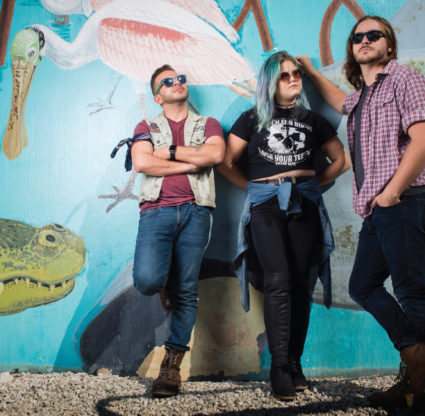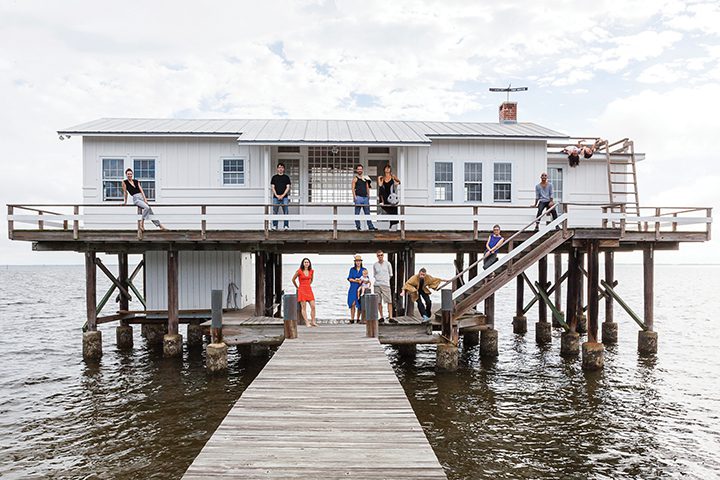It’s déjà vu. Six years ago, I took my first garden walk with Brian Holley, CEO of Naples Botanical Garden. Like today, it was a steamy summer afternoon, just a few days before the garden was scheduled to close its doors on the first chapter of its journey. Four months later, like one of its own native butterflies, the budding young garden emerged from its chrysalis and spread her wings in a stunning demonstration of living, breathing art. Among the unveilings in 2009 were a 90-acre nature preserve, exotic Brazilian and Caribbean gardens, a meandering pond with Jurassic-sized lily pads and a movie-set children’s garden shaded by a towering ficus treehouse. There were one-of-a-kind pieces by renowned artists and sculptors, a dramatic coralstone pergola and an Everglades-style birding tower overlooking faithfully restored native wetlands. Guests and patrons were inspired, and an entire community began to believe that one day the world-class garden envisioned by a handful of dreamers would, in fact, come to pass.
It didn’t hurt that, three years before, the board of directors had recruited Charles M. Berger, renowned for his keen marketing mind, as chairman, and Brian E. Holley, one of the nation’s most accomplished botanical garden executives, as CEO. The board dreamed big, and this duo was up to the challenge. Under them, and in a strategic partnership with the Cleveland Botanical Garden, where Holley was executive director, they crafted and began implementation of a master plan that could become not just a world-class botanical garden, but potentially one of the most significant botanical gardens in the world.
The garden is about to close its doors again, in preparation for its third, and most stunning, incarnation to date. Chapter three begins with the reopening on Oct. 23.
As we walk, Brian candidly reflects on his personal garden journey so far.
Gulfshore Life: You once dreamed of homesteading deep in the Canadian wilderness. What happened?
Brian Holley: I was 22 years old, taking a break from college, and my wife-to-be and I were helping some friends clear land to build a home on their remote 2,000-acre ranch in British Columbia. It seemed very exciting to me then, carving out a life in the wilderness. So I went back to school and got a forestry degree, then worked hard in Ontario for a few years, saving up money for my ranch. But by then we had a baby daughter, and the idea of a trek to the outhouse at 30 below had substantially lost its appeal. I took a chance and cold-called the Royal Botanical Gardens in Burlington, Ontario. I was a little shocked when they hired me on the spot as a trail manager. After 17 years there as a horticulturist, and ultimately manager of marketing, I got a call from the Cleveland Botanical Garden inviting me to spearhead their capital expansion. I spent the next 13 years there.
Brian does not mention what I subsequently learned: Under his leadership, the garden brought in $50 million in new facilities, including three significant gardens. He also established The Green Corps, an innovative urban farming program employing inner-city youth, which has become a national model.
GL: At some point during that time, you met Chuck Berger?
Holley: Yes, at a flower show in 1993. He was CEO of Scott’s Miracle Gro and had ties in Naples. Chuck and I were on a design team project together, and we became instant, lifetime friends. Twelve years later, over lunch, I told him that the fledgling botanical garden in Naples had contacted me about coming on as CEO. To start a botanical garden from scratch is a once-in-a-lifetime opportunity. Half-jokingly I said to Chuck, “If you’ll come be the board chairman, I’ll take the job as CEO”. He did, and I did. He was a wonderful friend. I admired him and enjoyed his great sense of humor. Though he dressed like a businessman, he had this one quirk: He was known for his crazy, colorful socks.
GL: What you did next was ambitious and expensive.
Holley: What we did next—at the direction and with full support of the board—was to seek out the top landscape architects in the world to design the next phase of the garden. If you plan to have a world-class garden, you need world-class visionaries who can take it there. We secured Raymond Jungles, Herb Schaal, Made Wijaya and Bob Truskowski … literally the landscape architects of the stars. We brought on well-known local landscape architect Ellin Goetz to coordinate the process.
To design the buildings, we retained Ted Flato of the renowned architectural firm Lake/Flato. The pinnacle of Ted’s work for us to date, the Eleanor and Nicholas Chabraja Visitor Center, will be revealed when we reopen in October.
GL: Chuck passed away in 2008, without seeing the dream come true?
Holley: Yes. The opening was in November 2009. One day not long after, I was walking through the construction site of the Children’s Garden, and noticed something odd about the trunk of the huge Royal Poinciana tree at its center. I thought, “That tree has a foot! We could paint some striped socks on it and name it Chuck, the Royal Poinciana!” And so we did. It’s very meaningful to those of us who knew and loved Chuck, and it’s also a statement about our commitment to the fun character of the Children’s Garden. Chuck lives on in other ways, too. His widow, Jane Berger, shared his love of color and excitement. She is one of the creative minds behind our iconic Hats in the Garden fundraiser and was named to the board in 2009.
GL: Your passion for the children’s programs is hard to hide.
Holley: Kids are intuitive nurturers. When you nurture a garden, it nurtures you. It makes you feel good about yourself and your world. I love it that you can plant some bean seeds and give it a little water, and in two weeks you have a bean plant.
And it’s more than that. In so many areas of life, you need certain skill sets to be successful. In sports, it’s athletic ability; in science or math, you need a high level of academic skills. But digging in the dirt is something anyone can do. You may have cerebral palsy, or Down syndrome, another physical challenge, whatever. But you can sit on the ground like other kids. You can plant seeds, water flowers, or dig weeds on your hands and knees, or in a wheelchair. And regardless of intellectual abilities, you can produce a vegetable as beautiful as any other.
GL: I love it that a botanical garden can be sophisticated and polished in the right places, yet knows when not to take itself so seriously.
Holley: Exactly! Teaching gardening to kids at the Royal Botanical Garden in Ontario gave me some insight into kids’ psyches. They love goofy stuff. When we created the Scavenger’s Garden here, the whole staff got into the project, going to junk stores, bringing stuff from home. I was adamant that it would be fun and surprising. We rotate objects in and out so there’s always something interesting to discover, like that clogged-up toilet over there [points to a vintage toilet bowl, “clogged” with caladiums]. Besides our members and guests, we have about 4,000 Collier County students here each year, and many are working on horticultural projects.
We’re headed toward my personal favorite place now, a series of coralstone pillars with a trellised roof, draped in wisteria-like vines. That vine is actually Queen’s Wreath, Brian says. But he has another vine on his mind, and his excitement is evident in his long stride, now several paces ahead of me.
Holley: I want you to see this. It is extremely rare in the plant world to have a flower the color of jade [gently lifting a vine covered in jade-green blossoms]. The inspiration for this pergola came from the private estate of renowned Caribbean horticulturist Iris Bannochie, which on her death she bequeathed to the Barbados National Trust.
I had the privilege of meeting Iris, and twice visited her spectacular Andromeda Garden in Barbados. One of the garden’s focal points is a coralstone pergola hung with jade vines. Iris was also a great mentor of Bob Truskowski, and when Bob suggested we re-create her pergola here in the Garden, I was totally supportive. The jade vine did beautifully here until we lost it in the unusually cold winter of 2010. This is the new vine’s first blooming.
We’ve arrived in the Asian Garden, with plantings, sculptures and water features invoking temples and sacred places of ancient Bali, Java, Thailand, India and China. It feels especially serene and cool in the Thai Riverside Pavilion, overlooking the lotus pond.
GL: Gardens are very spiritual places. Have you personally experienced what you’d describe as a spiritual moment in the Naples Botanical Garden?
Holley: Yes. It’s a great story. Not surprisingly, it occurred right here in this pavilion, and it was shared by 50 or 60 of us at the same time. A group of Tibetan monks who had fled to India to escape Chinese persecution had just completed an 18-month U.S. tour, making mandalas to raise money to support their monastery. They were exhausted and needed a break, and the organizer called to see if we could help. One of our board members offered them lodging right here for the week.
It was cool to see monks in saffron robes wandering quietly through the gardens. As a thank-you on their last day, they offered to perform a purification ceremony to bless the gardens. We all gathered at the pavilion. It started calmly, with chanting and bells, and gradually got noisier and more chaotic. At the highest moment, representing the expelling of negative spirits, a big wind blew through the Asian Garden, causing the bamboo to sway and rattle. Then, as suddenly as it started, the wind died down, leaving all of us with a case of goose bumps.
As we round a corner on the path, Brian gives me a heads-up: We’re about to enter the most controversial spot in Naples Botanical Garden.
GL: It looks like a field of wildflowers to me. I love fields of wildflowers.
Holley: Exactly the point. People either love it or they really hate it. The nature of a wildflower field is that it is wild. I’m on the “love it” side. My feeling is that the garden has two personalities: the created and exotic, balanced with the wonderful sense-ofplace in our native wetlands, the River of Grass and indigenous plantings. The counterpoint is that such an unkempt-looking patch is out of place among the better-tended gardens. The discussion isn’t over yet.
GL: What excites you most about the new Chabraja Visitor Center?
Holley: We always knew we wanted Ted Flato to design something worthy of a world-class botanical garden. Not only is he incredibly gifted, but also his firm, Lake/Flato, is a world leader in sustainable design. We fully expect that when finished it will qualify for the coveted LEED (Leadership in Energy and Environmental Design) Gold Certification.
Ted envisioned a shady lattice-covered boat, strategically positioned to provide unobstructed garden views. I mentioned the two personalities of the Naples Botanical Garden. Facing one way, you focus on the exotic Brazilian Garden with its stunning Roberto Burle Marx mosaic wall and the waterfall; facing the other way, you get vistas of the one-mile watershed and native Florida wetlands.
GL: What is this beautiful flower that looks almost like a plumeria?
Holley: Actually, that’s exactly what it is. With about 500 types of plumeria here, the Naples Botanical Garden has the distinction of holding the national collection of the genus Plumeria. Each one has been authenticated by botanical experts, and as a safety measure in case of catastrophe we have planted duplicates of our most critical types at the Belize Botanical Garden. We work closely with the Plumeria Society of America in an effort to complete the collection.
GL: Is the Garden poised to create any more collections with global impact?
Holley: Yes. In fact, The LaGrippe Orchid Garden is one of our most exciting reveals for this fall. To date, the collection has more than 1,000 orchids, including some of the smallest and largest in the world. In an era when many botanical gardens are focusing on exhibits, I remain “old school,” keeping sight of our mission to preserve and protect the world’s plant species and cultivars. As members of the North American Plant Collections Consortium, we look toward having other national collections in the next few years, such as possibly bougainvillea or palm species. We currently have ongoing relationships with Marie Selby Botanical Gardens and Fakahatchee Strand Preserve State Park and others, to maintain significant healthy populations of this region’s endangered native species, such as Tillandsias (air plants). Our goal is to be in a position to re-establish these plants if necessary.
I have one final question before we part. Brian’s small intake of breath, then hearty laugh, tells me that he hasn’t been asked this question before.
GL: If you could return to the Garden half a century or so from now, what affectionate symbol might you see in honor of the impact you’ve made here?
Holley: If you were to ask my staff, I imagine it would have something to do with hats. Everyone knows my love of big Panama hats. I have seven in my office here, and a zillion more at home. I’m never in the garden without one. It kind of fits the garden, and being in Florida with this chrome dome of mine, it’s also very important.
A permanent, and very meaningful, Hat in the Garden. How fitting.
NEXT OPENING
Member preview events are Oct. 18 and 19. Public opening is Oct. 23. naplesgarden.org, 643-7275





